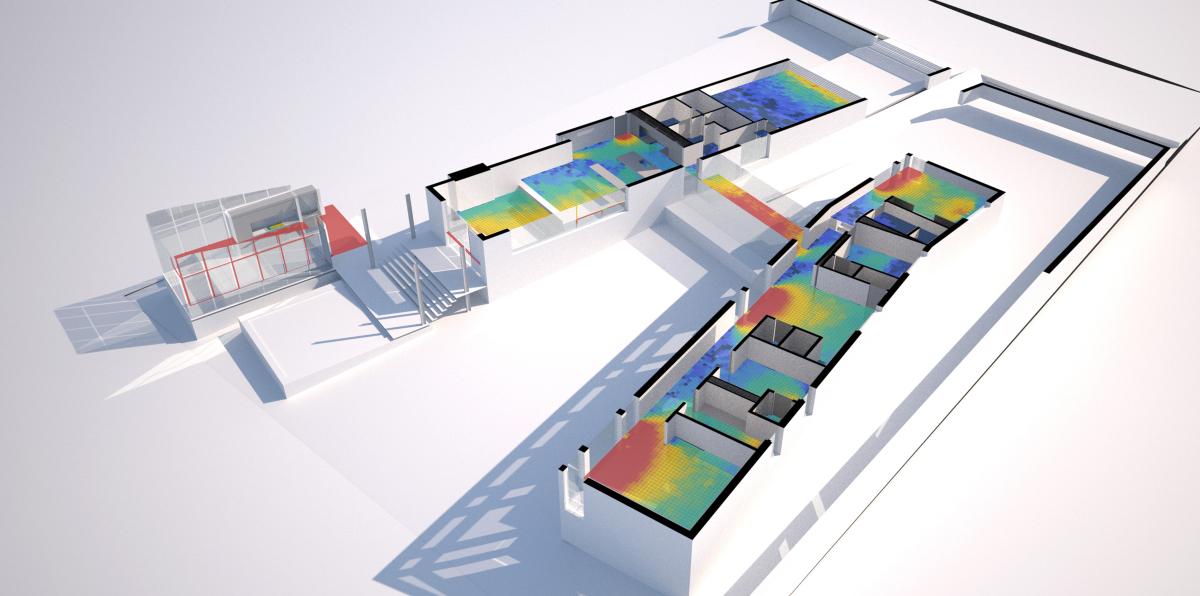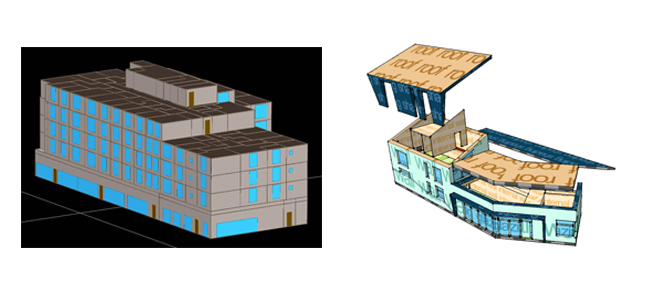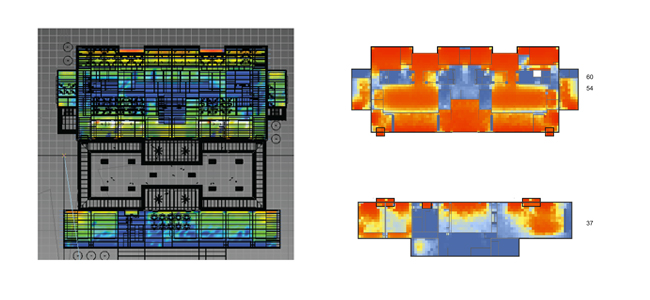THE DOGRUN
a place to share ideas


The State of Simulation
Posted by coreysquire on 1/11/17 at 10:05 am
It's generally agreed that building performance simulation is the best method for realizing a building’s sustainability potential. In theory, a project team will run an energy or daylight simulation to study the hypothetical performance of a design and then use the simulation outcomes to make targeted improvements. This process promises to improve the efficiency, comfort, and all-around performance of a design. In the architecture community, building performance simulation is such a significant component of sustainable design that for 2030 reporting, the metric “percent of floor area modeled” is almost as important as “total energy reduction”.
Despite this, building performance simulation has not yet lived up to its promise. The majority of questions that designers might have do not result in a simulation and the majority of simulations do not result in positive changes to the design. This leaves a huge amount of building performance potential on the table.
The reason that simulations have failed to deliver widespread improvements is that the state of simulation today is slow and ugly. Most often, Information generated by simulations doesn't get to the design team in time to be part of design process, and when it does the output is often graphically uninteresting or meaningless to most designers. We all repeat anecdotes about the time when the perfect simulation was performed at the perfect time and resulted in a much better project, but this is the exception that proves the rule. Simulation should be happening on all projects as an integral part of the design process. We don't repeat stories about the moment we chose a specific doorknob.
 Image 1: The graphic environmental of eQuest of the left and Sefaira on the right. Clunky graphics make it difficult for architects to react to energy models in a meaningful way.
It order for a simulation process to realize significant, portfolio-wide performance improvements, the turnaround time would need to be fast, and few hours at most, and the outcome would need to consist of presentation quality graphics that are interesting to look at and simple to understand.
Ever since building performance simulation became a major component of sustainable design, we who perform the simulations have imagined a future "Singularity". A single, all inclusive, building simulation interface that could provide real-time feedback, fit into an iterative design process, and achieve true evidence-based design. This platform would allow us to pump out fast, accurate simulations that would be graphically consistent and give teams relevant and timely design direction.
It seemed obvious for a long time that this “simulation and graphic representation Singularity” would grow out of Revit. Autodesk bought up Ecotect and other similar platforms and produced proto-simulation tools such as Vasari, but time after time, Autodesk failed to deliver a simulation platform as intelligent and integrated as Revit. Sefaira promised to integrate Revit with real-time energy and daylight, but turned out to be a false profit with glitchy software, limited functionality, and little to show beyond an aggressive marketing strategy. But while Autodesk was buying up software and Sefaira was making marketing calls, a small community of simulationists and programmers were transforming Grasshopper, Rhino’s parametric companion, into a powerful and all-encompassing building simulation platform.
Image 1: The graphic environmental of eQuest of the left and Sefaira on the right. Clunky graphics make it difficult for architects to react to energy models in a meaningful way.
It order for a simulation process to realize significant, portfolio-wide performance improvements, the turnaround time would need to be fast, and few hours at most, and the outcome would need to consist of presentation quality graphics that are interesting to look at and simple to understand.
Ever since building performance simulation became a major component of sustainable design, we who perform the simulations have imagined a future "Singularity". A single, all inclusive, building simulation interface that could provide real-time feedback, fit into an iterative design process, and achieve true evidence-based design. This platform would allow us to pump out fast, accurate simulations that would be graphically consistent and give teams relevant and timely design direction.
It seemed obvious for a long time that this “simulation and graphic representation Singularity” would grow out of Revit. Autodesk bought up Ecotect and other similar platforms and produced proto-simulation tools such as Vasari, but time after time, Autodesk failed to deliver a simulation platform as intelligent and integrated as Revit. Sefaira promised to integrate Revit with real-time energy and daylight, but turned out to be a false profit with glitchy software, limited functionality, and little to show beyond an aggressive marketing strategy. But while Autodesk was buying up software and Sefaira was making marketing calls, a small community of simulationists and programmers were transforming Grasshopper, Rhino’s parametric companion, into a powerful and all-encompassing building simulation platform.
 Image 2: A daylight simulation performed on the same project is 3DS Max on the left and DIVA on the right. Both models were exported from Revit, but the DIVA simulation took a fraction of the time and resulted in much clearer graphics.
For us at Lake | Flato, the waiting is over, the Singularity has arrived!
It's now clear that due to its potential for automation, infinite customization, and the availability of powerful simulation plug-ins, the long awaited “Singularity” will be based in Grasshopper. By combining building simulation plug ins such as DIVA, ArchSim, and Ladybug with the flexibility of Grasshopper, simulationists are no longer bound by the constraints of their software. It's possible to do anything that can be scripted, and because of this, Grasshopper is the only platform that a simulationist would ever need.
In the past, the state of simulation was suffering from a lack of speed, flexibility, and beauty. Using Grasshopper as a single simulation platform solves all of these problems by allowing multiple simulations on a single model, graphically appealing outputs, and turnaround times that can influence decision making. Over the next year, we'll be transitioning all of our simulations to Grasshopper and documenting our process here on the Dogrun.
Looking forward in 2017, the state of simulation is strong.
Image 2: A daylight simulation performed on the same project is 3DS Max on the left and DIVA on the right. Both models were exported from Revit, but the DIVA simulation took a fraction of the time and resulted in much clearer graphics.
For us at Lake | Flato, the waiting is over, the Singularity has arrived!
It's now clear that due to its potential for automation, infinite customization, and the availability of powerful simulation plug-ins, the long awaited “Singularity” will be based in Grasshopper. By combining building simulation plug ins such as DIVA, ArchSim, and Ladybug with the flexibility of Grasshopper, simulationists are no longer bound by the constraints of their software. It's possible to do anything that can be scripted, and because of this, Grasshopper is the only platform that a simulationist would ever need.
In the past, the state of simulation was suffering from a lack of speed, flexibility, and beauty. Using Grasshopper as a single simulation platform solves all of these problems by allowing multiple simulations on a single model, graphically appealing outputs, and turnaround times that can influence decision making. Over the next year, we'll be transitioning all of our simulations to Grasshopper and documenting our process here on the Dogrun.
Looking forward in 2017, the state of simulation is strong.
 Image 1: The graphic environmental of eQuest of the left and Sefaira on the right. Clunky graphics make it difficult for architects to react to energy models in a meaningful way.
It order for a simulation process to realize significant, portfolio-wide performance improvements, the turnaround time would need to be fast, and few hours at most, and the outcome would need to consist of presentation quality graphics that are interesting to look at and simple to understand.
Ever since building performance simulation became a major component of sustainable design, we who perform the simulations have imagined a future "Singularity". A single, all inclusive, building simulation interface that could provide real-time feedback, fit into an iterative design process, and achieve true evidence-based design. This platform would allow us to pump out fast, accurate simulations that would be graphically consistent and give teams relevant and timely design direction.
It seemed obvious for a long time that this “simulation and graphic representation Singularity” would grow out of Revit. Autodesk bought up Ecotect and other similar platforms and produced proto-simulation tools such as Vasari, but time after time, Autodesk failed to deliver a simulation platform as intelligent and integrated as Revit. Sefaira promised to integrate Revit with real-time energy and daylight, but turned out to be a false profit with glitchy software, limited functionality, and little to show beyond an aggressive marketing strategy. But while Autodesk was buying up software and Sefaira was making marketing calls, a small community of simulationists and programmers were transforming Grasshopper, Rhino’s parametric companion, into a powerful and all-encompassing building simulation platform.
Image 1: The graphic environmental of eQuest of the left and Sefaira on the right. Clunky graphics make it difficult for architects to react to energy models in a meaningful way.
It order for a simulation process to realize significant, portfolio-wide performance improvements, the turnaround time would need to be fast, and few hours at most, and the outcome would need to consist of presentation quality graphics that are interesting to look at and simple to understand.
Ever since building performance simulation became a major component of sustainable design, we who perform the simulations have imagined a future "Singularity". A single, all inclusive, building simulation interface that could provide real-time feedback, fit into an iterative design process, and achieve true evidence-based design. This platform would allow us to pump out fast, accurate simulations that would be graphically consistent and give teams relevant and timely design direction.
It seemed obvious for a long time that this “simulation and graphic representation Singularity” would grow out of Revit. Autodesk bought up Ecotect and other similar platforms and produced proto-simulation tools such as Vasari, but time after time, Autodesk failed to deliver a simulation platform as intelligent and integrated as Revit. Sefaira promised to integrate Revit with real-time energy and daylight, but turned out to be a false profit with glitchy software, limited functionality, and little to show beyond an aggressive marketing strategy. But while Autodesk was buying up software and Sefaira was making marketing calls, a small community of simulationists and programmers were transforming Grasshopper, Rhino’s parametric companion, into a powerful and all-encompassing building simulation platform.
 Image 2: A daylight simulation performed on the same project is 3DS Max on the left and DIVA on the right. Both models were exported from Revit, but the DIVA simulation took a fraction of the time and resulted in much clearer graphics.
For us at Lake | Flato, the waiting is over, the Singularity has arrived!
It's now clear that due to its potential for automation, infinite customization, and the availability of powerful simulation plug-ins, the long awaited “Singularity” will be based in Grasshopper. By combining building simulation plug ins such as DIVA, ArchSim, and Ladybug with the flexibility of Grasshopper, simulationists are no longer bound by the constraints of their software. It's possible to do anything that can be scripted, and because of this, Grasshopper is the only platform that a simulationist would ever need.
In the past, the state of simulation was suffering from a lack of speed, flexibility, and beauty. Using Grasshopper as a single simulation platform solves all of these problems by allowing multiple simulations on a single model, graphically appealing outputs, and turnaround times that can influence decision making. Over the next year, we'll be transitioning all of our simulations to Grasshopper and documenting our process here on the Dogrun.
Looking forward in 2017, the state of simulation is strong.
Image 2: A daylight simulation performed on the same project is 3DS Max on the left and DIVA on the right. Both models were exported from Revit, but the DIVA simulation took a fraction of the time and resulted in much clearer graphics.
For us at Lake | Flato, the waiting is over, the Singularity has arrived!
It's now clear that due to its potential for automation, infinite customization, and the availability of powerful simulation plug-ins, the long awaited “Singularity” will be based in Grasshopper. By combining building simulation plug ins such as DIVA, ArchSim, and Ladybug with the flexibility of Grasshopper, simulationists are no longer bound by the constraints of their software. It's possible to do anything that can be scripted, and because of this, Grasshopper is the only platform that a simulationist would ever need.
In the past, the state of simulation was suffering from a lack of speed, flexibility, and beauty. Using Grasshopper as a single simulation platform solves all of these problems by allowing multiple simulations on a single model, graphically appealing outputs, and turnaround times that can influence decision making. Over the next year, we'll be transitioning all of our simulations to Grasshopper and documenting our process here on the Dogrun.
Looking forward in 2017, the state of simulation is strong.